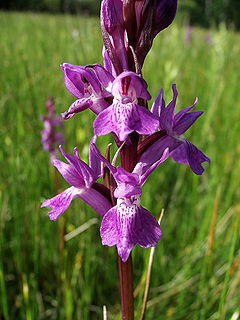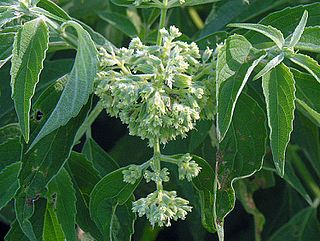Erythrococca is a plant genus of the family Euphorbiaceae, first described in 1849. It is native to Africa and the Arabian Peninsula.
Discoglypremna is a plant genus of the family Euphorbiaceae first described as a genus in 1911. It contains only one known species, Discoglypremna caloneura, native to tropical Africa.

Spiranthes is a genus of orchids in the subfamily Orchidoideae. They are known commonly as ladies tresses, ladies'-tresses, or lady's tresses. The genus is distributed in the Americas, Eurasia, and Australia. The genus name Spiranthes is derived from the Greek speira ("coil") and anthos ("flower"), and was inspired by the spirally arranged inflorescence.

Basilicum is a genus of plants in the Lamiaceae, first described in 1802. It contains only one known species, Basilicum polystachyon, native to Africa, Madagascar, southern Asia, New Guinea, Australia, and various islands of the Pacific and Indian Oceans.
Pleioceras is a genus of plants in the family Apocynaceae, first described as a genus in 1888. It is native to tropical Africa.

Lasimorpha is a monotypic genus of flowering plants in the family Araceae. The single species that makes up the genus is Lasimorpha senegalensis. This species is native to western and central Africa, from Liberia east to Chad and south to Angola.

Dactylorhiza elata, the robust marsh orchid, is a species of flowering plant in the family Orchidaceae, native to the western Mediterranean region.

Eulophia alta is a species of orchid, known as the wild coco. It is widespread across tropical and subtropical parts of Africa, South America, Central America, Mexico and the West Indies, as well as the southeastern United States.
Bewsia is a genus of African plants in the grass family. The only known species is Bewsia biflora, widespread across much of sub-Saharan Africa from Ivory Coast to Tanzania to KwaZulu-Natal.
Hanna Bogna Margońska, born 1968 is a Polish botanist known for her work on orchids.

Discyphus is a genus of flowering plants from the orchid family, Orchidaceae. It is the only genus in the subtribe Discyphinae of the tribe Cranichideae. It contains only one currently recognized species, Discyphus scopulariae, with two accepted varieties:
Galeottiella is a genus of flowering plants from the orchid family, Orchidaceae. Traditionally it had been included in subtribe Spiranthinae, but following molecular phylogenetic and morphological studies it is now placed in a subtribe on its own, Galeottiellinae.
Summerhayesia is a genus of flowering plants from the orchid family, Orchidaceae. It has two known species, both native to tropical Africa.
Vossia is a genus of Asian and African plants in the grass family.
Motandra is a genus of plant in the family Apocynaceae native to tropical Africa. As of August 2013 the World Checklist of Selected Plant Families recognises 3 species:
- Motandra guineensis(Thonn.) A.DC. - widespread from Liberia to Sudan and south to Angola
- Motandra lujaeDe Wild. & T.Durand - Gabon, Congo, Cabinda, Equatorial Guinea, Zaire
- Motandra poecilophyllaWernham - Gabon, Congo, Equatorial Guinea, Cameroon
- Motandra erlangeriK.Schum = Oncinotis tenuilobaStapf
- Motandra glabrataBaill. = Oncinotis glabrata(Baill.) Stapf ex Hiern
- Motandra viridifloraK.Schum. = Baissea viridiflora(K.Schum.) de Kruif
- Motandra welwitschianaBaill. = Oncinotis hirtaOliv.
Leslie Andrew Garay was an American botanist. He is the retired curator of the Oakes Ames Orchid Herbarium at Harvard University, where he succeeded Charles Schweinfurth in 1958. In 1957 he was awarded a Guggenheim Fellowship.
Orestias is a genus of orchids. It has 4 known species, all native to central Africa, including the island of São Tomé in the Gulf of Guinea.
- Orestias elegansRidl. - São Tomé, Príncipe
- Orestias foliosaSummerh. in G.M.D.Troupin - Gabon, Zaire
- Orestias micranthaSummerh. - São Tomé, Cameroon, Equatorial Guinea
- Orestias stelidostachya(Rchb.f.) Summerh. - São Tomé

Hoslundia is a genus of flowering plant in the family Lamiaceae, first described in 1804. It contains only one known species, Hoslundia opposita. It is widespread across much of sub-Saharan Africa including Madagascar.

Clitandra is a genus of flowering plants in the family Apocynaceae, first described as a genus in 1849. A total of 46 names have been coined since that time for species, subspecies, and varieties within the genus, but most of them have been transferred to other genera. The genus is currently regarded as containing only one species, Clitandra cymulosa, native to tropical Africa.
Saba is a genus of plant in the family Apocynaceae first described as a genus in 1849. It is native to Madagascar, Comoros, and mainland Africa.








